 My talk today is about avoiding this. Both the broken 400mm water main on the
left, and
the twenty thousand Euro hole in the ground on the right that was required to
replace it. We may avoid it better than anybody. Every city claims to be
the best, but hear me establish it about Calgary and construction and we'll see.
My talk today is about avoiding this. Both the broken 400mm water main on the
left, and
the twenty thousand Euro hole in the ground on the right that was required to
replace it. We may avoid it better than anybody. Every city claims to be
the best, but hear me establish it about Calgary and construction and we'll see.
First, our bona fides for doing a great deal of pipe laying.
fullscreen
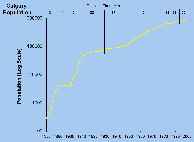 Calgary is a city in western Canada that this year
will reach one million in population.
Calgary is a city in western Canada that this year
will reach one million in population.
As this graph shows, it has reached that size with one of the fastest
growth rates in history. The population graph for Calgary over the last
120 years has to use a logarithmic scale, going from the 1880s...
fullscreen
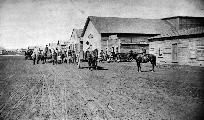 ...when it had just a few hundred people.
...when it had just a few hundred people.
fullscreen
 Through the decades when the population doubling time was just 3 years -
that's the numbers shown along the top of the graph - to a population in
the tens of thousands by 1912...
Through the decades when the population doubling time was just 3 years -
that's the numbers shown along the top of the graph - to a population in
the tens of thousands by 1912...
fullscreen
 ...when it was already a bustling city.
...when it was already a bustling city.
fullscreen
 By the end of the War, we were at 100,000 and it has increased ten-fold
to a million since, so we have experience at rapid building now, for half a century.
We currently add over 20 000 new citizens each year and must construct
eight or nine thousand new homes for them.
By the end of the War, we were at 100,000 and it has increased ten-fold
to a million since, so we have experience at rapid building now, for half a century.
We currently add over 20 000 new citizens each year and must construct
eight or nine thousand new homes for them.
fullscreen
 My office is about a 60m south and 60m up from that 1888 photograph. This
2001 photograph does not show several tall apartment buildings about
1 kilometre to the west of it, that were constructed in the last 3 years.
My office is about a 60m south and 60m up from that 1888 photograph. This
2001 photograph does not show several tall apartment buildings about
1 kilometre to the west of it, that were constructed in the last 3 years.
fullscreen
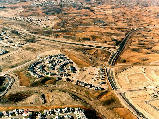 But most of our growth has been the urban sprawl so unfortunately typical
of North America. For each new citizen, we therefore must lay 5m of
water pipe each year: 120km installed in 2003. And similar amounts
of sanitary and storm sewer. For our size, we may be your best customer
in the world.
But most of our growth has been the urban sprawl so unfortunately typical
of North America. For each new citizen, we therefore must lay 5m of
water pipe each year: 120km installed in 2003. And similar amounts
of sanitary and storm sewer. For our size, we may be your best customer
in the world.
fullscreen
 But the money we spend on pipe is small compared to the money we spend
putting it in. The frost line in Calgary in our worst winters goes
below 2.5m deep, so we put all three pipes - water, storm sewer, and
sanitary - in trenches 3m deep.
But the money we spend on pipe is small compared to the money we spend
putting it in. The frost line in Calgary in our worst winters goes
below 2.5m deep, so we put all three pipes - water, storm sewer, and
sanitary - in trenches 3m deep.
fullscreen
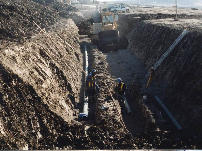 The so-called triple trench is some 6m wide at the bottom and over
9 wide at the top.
The so-called triple trench is some 6m wide at the bottom and over
9 wide at the top.
The dozen or more crews that are doing this on any given day
cost nearly 4000 Euros per hour for all that equipment.
fullscreen
 By my estimate, Calgary developers must excavate nearly 7 million tonnes of
earth each year. We when you do that,
you really, really don't want to dig it up again, nor for your
grandchildren to do so.
By my estimate, Calgary developers must excavate nearly 7 million tonnes of
earth each year. We when you do that,
you really, really don't want to dig it up again, nor for your
grandchildren to do so.
fullscreen
 I have a database of every pipe in Calgary with an installation date on each.
I have a database of every pipe in Calgary with an installation date on each.
fullscreen
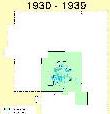 The Geographic Information System lets me make these maps that show
Calgary's history of water mains installations.
The Geographic Information System lets me make these maps that show
Calgary's history of water mains installations.
fullscreen
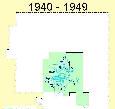 Each map is one decade, the light blue is all the pipes from before
that decade, the dark blue is pipes constructed during the decade.
Each map is one decade, the light blue is all the pipes from before
that decade, the dark blue is pipes constructed during the decade.
fullscreen
 So you can see that starting after the War, our growth became
fast...
So you can see that starting after the War, our growth became
fast...
fullscreen
 Then faster....
Then faster....
fullscreen
 Then explosive.
Then explosive.
It was during this decade, the 1970's, that we went through a
crisis. We expanded into the northeast area, outside the downtown
river valley, into a flatland of former marshes that were highly
corrosive soil. It was just as we had switched to ductile iron pipe.
The soil ate it alive. We were later replacing some of them
after 15 or even 10 years.
fullscreen
 The financial crisis this caused profoundly affected the history of our
waterworks for
this last 30 years. This black line on this graph, against the Y-axis
on the right, shows the number of mains repairs we have had each year
since the late 1960's. Since each repair needs a 3m deep hole in the ground,
each costs a day or more of service and about 5000 Euros...several million Euros
per year at the peak of 1800 in the 1980's.
The financial crisis this caused profoundly affected the history of our
waterworks for
this last 30 years. This black line on this graph, against the Y-axis
on the right, shows the number of mains repairs we have had each year
since the late 1960's. Since each repair needs a 3m deep hole in the ground,
each costs a day or more of service and about 5000 Euros...several million Euros
per year at the peak of 1800 in the 1980's.
The blue bars show the amount of main
replacement we did in kilometers against the left Y-axis. If
you multiply this 35km peak by the current figure of 450000 Euros per
kilometer, you see it was over 10 million Euros per year. At those prices,
we definitely weren't going to put in main that was going to die in
10 or even 30 years, we had to find something better. Since we did,
and since we replaced the ductile iron with pipe that didn't corrode,
the breaks have gone back down into the 400's and we've steadily
reduced the replacement program.
fullscreen
 The two materials this crisis made us switch to, are shown here on this
other map from my GIS, which colours the pipes by material type. It's
also a kind of history. The older centre of town is
mostly still dark blue, for old thick-wall cast-iron, and magenta around it, for
the later thin-wall cast iron. Light blue is the ductile iron that
corroded so quickly. The yellow is also ductile iron, but we call
it a different material type entirely, YDI, for yellow-jacketed
ductile-iron, a corrosion-protected product invented by the
oil industry. We knew it well because Calgary is an oil city. We
took the lead in adapting it for the water industry. And the newest
ring, the green, is the PVC we've been putting in for over twenty-seven years now.
The two materials this crisis made us switch to, are shown here on this
other map from my GIS, which colours the pipes by material type. It's
also a kind of history. The older centre of town is
mostly still dark blue, for old thick-wall cast-iron, and magenta around it, for
the later thin-wall cast iron. Light blue is the ductile iron that
corroded so quickly. The yellow is also ductile iron, but we call
it a different material type entirely, YDI, for yellow-jacketed
ductile-iron, a corrosion-protected product invented by the
oil industry. We knew it well because Calgary is an oil city. We
took the lead in adapting it for the water industry. And the newest
ring, the green, is the PVC we've been putting in for over twenty-seven years now.
fullscreen
 But before PVC, we tried this product that made us very careful
pipe installers, starting a tradition that makes us very good PVC installers.
Yellow-jacketed ductile iron uses a heavy, high-density polyethylene jacket.
But before PVC, we tried this product that made us very careful
pipe installers, starting a tradition that makes us very good PVC installers.
Yellow-jacketed ductile iron uses a heavy, high-density polyethylene jacket.
A loose piece of the jacket material is shown here beside a pipe sample.
fullscreen
 Unlike poly-wrap, it is tightly bonded to the pipe,
and it is five times as thick.
Unlike poly-wrap, it is tightly bonded to the pipe,
and it is five times as thick.
fullscreen
 Even then, we consider it useless without cathodic protection, so we
put electrical bonding straps between the pipes, with the strap ends
protected from the soil by a bubble of gell, and we attach a magnesium
anode every hundred metres.
Even then, we consider it useless without cathodic protection, so we
put electrical bonding straps between the pipes, with the strap ends
protected from the soil by a bubble of gell, and we attach a magnesium
anode every hundred metres.
fullscreen
 We make certain that the coating is not so much as scratched.
YDI pipes are shown here waiting for installation on old tires to ensure the
coating doesn't touch rocks. Then the pipes are lowered into the trench by
cloth straps.
We make certain that the coating is not so much as scratched.
YDI pipes are shown here waiting for installation on old tires to ensure the
coating doesn't touch rocks. Then the pipes are lowered into the trench by
cloth straps.
All of this is a lot of trouble: Corrosion technicians
on site, careful handling, jeeping to detect coating breaks,
magnesium anodes...it was probably
half the speed and nearly twice the cost of bare DI to install.
But we learned to do it because we had to.
fullscreen
 And more important, we had the political capital, from all the
main breaks and their costs, to force our powerful developer community to
switch to it as well.
And more important, we had the political capital, from all the
main breaks and their costs, to force our powerful developer community to
switch to it as well.
As the yellow in this map shows,
we put in over 600 km of YDI between 1973 and 1982. After 600km, most
of it in 8 years, all Calgary contractors were slow, methodical
pipe installers and it was normal for Calgary construction inspectors
to be demanding and ruthless.
fullscreen
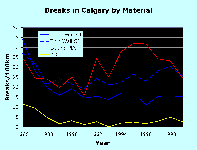 But YDI was well worth it.
This graph shows the main break rates in the traditional unit
of breaks per year per hundred kilometres. The ductile iron, in red, is the worst
with numbers in the thirties, the thicker cast iron in blue is better with about
20 breaks per hundred per year...but the YDI is an order of
magnitude better, only 3 or 4 breaks per hundred kilometres
per year.
But YDI was well worth it.
This graph shows the main break rates in the traditional unit
of breaks per year per hundred kilometres. The ductile iron, in red, is the worst
with numbers in the thirties, the thicker cast iron in blue is better with about
20 breaks per hundred per year...but the YDI is an order of
magnitude better, only 3 or 4 breaks per hundred kilometres
per year.
fullscreen
 Which brings the financial results on this slide. I've just lumped
all the CI and DI together under "unprotected metallic". That 1330
km still has 400 breaks per year costing us 1.9M Euros to fix. So we spend
4.8M Euros per year replacing it. We have also started
spending 1.4M of the old replacement budget retrofitting it with cathodic protection,
as a better value for money.
Which brings the financial results on this slide. I've just lumped
all the CI and DI together under "unprotected metallic". That 1330
km still has 400 breaks per year costing us 1.9M Euros to fix. So we spend
4.8M Euros per year replacing it. We have also started
spending 1.4M of the old replacement budget retrofitting it with cathodic protection,
as a better value for money.
The YDI, by contrast, has never had a replacement and has only 20 breaks per year, plus a few hundred thousand for cathodic protection monitoring and anode replacement.
Now, at long last, and thank you for your patience, we arrive
at your product. Late this year, we should install our 2000th kilometre
of PVC pipe, and it has just one or two breaks per year, so obviously
we never replace it. I mention that some year we will have to do
a little cathodic protection on that part of the system, only
because...
fullscreen
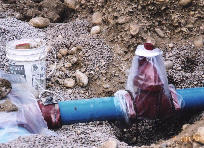 ...we still have to use metal for valves and some other fittings
and those have anodes that will one day wear out. The loose plastic
wrap on this valve is just to keep the real coating from being scratched;
the wire leads to the valve's own anode.
...we still have to use metal for valves and some other fittings
and those have anodes that will one day wear out. The loose plastic
wrap on this valve is just to keep the real coating from being scratched;
the wire leads to the valve's own anode.
fullscreen
 With metallic pipes, I'm used to treating breaks statistically.
With my PVC system, the breaks are individuals, with names. We
have had only twenty breaks in the last fourteen years, all of
them shown here.
With metallic pipes, I'm used to treating breaks statistically.
With my PVC system, the breaks are individuals, with names. We
have had only twenty breaks in the last fourteen years, all of
them shown here.
I have alternated blue and white backgrounds each year, with the year shown at left. You can see the good and bad years, such as the horrors of 1995 when we had four breaks, nearly 1% as many as on metallic. But for 2000 and 2001, there's just a note saying "no breaks".
Dividing each year's break-count by the number of hundreds of kilometres of PVC for that year, you see why I don't even try to show our PVC break-rate on that previous graph with the other materials. The rate is so low, you couldn't tell the line apart from the X-axis.
With metallic breaks, there are enough to speak of statistical averages; with PVC, an extra break or two can triple your average for a year, creating a wildly varying graph.
So, in my paper, I propose a new unit for measuring pipe failure rates that accomodates plastic materials, which I have put in the last column on the right. It is repairs per thousand kilometres, per decade, and is based on a 10 year moving average, rather than any one year's value.
I'd love to name this unit after the Chief Engineer of the Calgary Waterworks in the 1970's, who became our director and my first boss, Jim Bouck. Jim was the guy who got the yellow-jacket company to adapt their product to bell & spigot pipe, cutting breaks by an order of magnitude; then he championed our switch to PVC as soon as the C900 spec came out, cutting them a second order of magnitude. That's quite an achievement for one career.
Using that name, Calgary's current PVC failure rate is trending downward from 17 to 13 boucks. Our YDI break rate is rising from 300 to 350 boucks recently, and our DI failure rate is holding steady at about 3 kiloboucks.
In a 1992 report, several Canadian cities that we can be usefully compared to, had failure rates for PVC between 0.7 and 0.9 breaks/100km/year, or 70 to 90 boucks, as I would call it. Our failure rate is less than a quarter of that, and still dropping. The heart of my paper proposes a theory explaining this.
It comes from what you must note about the cause of every failure we have had. In all of them, the problem can be traced to a error of installation.
Every single one.
They were all preventable, if only construction practices could be perfect.
fullscreen
 Nearly half of the failures on that list come from cracks that propagated
away from a service tap. Either the tap was done too quickly, or with
a dull bit. Or, after tapping and connection, the service line was
levered around by the worker.
Nearly half of the failures on that list come from cracks that propagated
away from a service tap. Either the tap was done too quickly, or with
a dull bit. Or, after tapping and connection, the service line was
levered around by the worker.
fullscreen
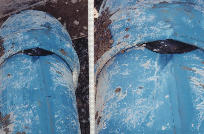 Second, a number of them had a leak at a gasket, either from the pipe
being deflected too far, or mostly from the gasket being rolled during
insertion. Once you have even a small leak, of course, it tends to
grow - this picture shows the erosion marks - and eventually the soil
is undercut.
Second, a number of them had a leak at a gasket, either from the pipe
being deflected too far, or mostly from the gasket being rolled during
insertion. Once you have even a small leak, of course, it tends to
grow - this picture shows the erosion marks - and eventually the soil
is undercut.
fullscreen
 We've had a couple of nasty failures on big 400mm mains recently,
both from cracked bells that were the result of over-insertion
with machines that made it too easy to push too far. We've changed
procedures since that installation year, forbidding machine installation.
We've had a couple of nasty failures on big 400mm mains recently,
both from cracked bells that were the result of over-insertion
with machines that made it too easy to push too far. We've changed
procedures since that installation year, forbidding machine installation.
fullscreen
 The Calgary inspectors of developer and contract construction are the
heroes of my paper. The only two specifications of ours that actually
differ from the manufacturers recommendations
are, number one: we insist on gravel or sand bedding for all our pipes
and for the entire pipe zone. Calgary has widely varying soils and
unless the native soil happens to be sand or rounded "non-injurious" gravel, the
contractor has to bring in enough to completely surround the pipe.
The Calgary inspectors of developer and contract construction are the
heroes of my paper. The only two specifications of ours that actually
differ from the manufacturers recommendations
are, number one: we insist on gravel or sand bedding for all our pipes
and for the entire pipe zone. Calgary has widely varying soils and
unless the native soil happens to be sand or rounded "non-injurious" gravel, the
contractor has to bring in enough to completely surround the pipe.
fullscreen
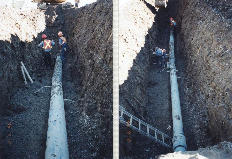 And secondly, we have tighter controls on deflection. Our recommended
deflection radius is a little larger than the manufacturers, but for
pipes over 200mm, we don't allow any deflection at all.
And secondly, we have tighter controls on deflection. Our recommended
deflection radius is a little larger than the manufacturers, but for
pipes over 200mm, we don't allow any deflection at all.
This deflection, for instance, was not allowed.
fullscreen
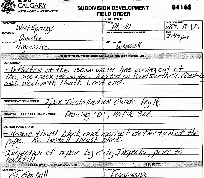 The inspector's enforcement device for such things is the
Field Work Order form, shown here. It says there's a deflection
he doesn't like, requires the contractor to remove it,
reinstall with no deflection, and
pour another thrust block. This will cost the contractor hours and thus
several thousand Euros or more.
The inspector's enforcement device for such things is the
Field Work Order form, shown here. It says there's a deflection
he doesn't like, requires the contractor to remove it,
reinstall with no deflection, and
pour another thrust block. This will cost the contractor hours and thus
several thousand Euros or more.
fullscreen
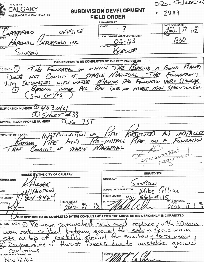 And this one is more expensive still. It notes that the soil
is very wet, spongy and unstable. It then instructs
the contractor to rip all the pipe out, remove the soil, and replace with
40mm washed rock, then re-install - and while he's at it, he should re-install
with thrust blocks twice as large, just in case.
And this one is more expensive still. It notes that the soil
is very wet, spongy and unstable. It then instructs
the contractor to rip all the pipe out, remove the soil, and replace with
40mm washed rock, then re-install - and while he's at it, he should re-install
with thrust blocks twice as large, just in case.
Our inspectors issue a couple of these forms every working day - over 400 last year. Very few did NOT cost a contractor thousands of Euros in lost time.
It's like safety or environmental issues. Staying safe, or following
environmental rules, demands constant vigilance and constant inspection and
reminder - and frankly, it also needs heavy fines. When a young inspector
has the full backing of our entire city corporation to fine you several
thousand Euros worth of time if he doesn't like your work, you learn to do good work.
fullscreen
 Speaking of thrust blocks and size
I'm told we can be a little conservative.
Speaking of thrust blocks and size
I'm told we can be a little conservative.
That's not a specification, just another thing that contractors would rather be conservative on rather than risk a dreaded field work order. I noticed this rather large one where the bend fitting was only a few degrees.
But it doesn't matter what the engineering calcs say, no engineer in
the whole city would disagree with a field call by an inspector.
We back them up. Every time. The point isn't whether he was more
conservative than an engineer: the point is that nobody questions
one of our inspectors and gets away with it.
fullscreen
 All our inspectors are experienced
pipemen, who get that job after a two week training course in which they
spend days practicing tapping. They are strictly trained to keep sharp
tapping bits, and they know what a coupon done by a dull bit looks like.
So they make the contractors save every one, they inspect every one, and
then they take the coupons away so they aren't re-used.
All our inspectors are experienced
pipemen, who get that job after a two week training course in which they
spend days practicing tapping. They are strictly trained to keep sharp
tapping bits, and they know what a coupon done by a dull bit looks like.
So they make the contractors save every one, they inspect every one, and
then they take the coupons away so they aren't re-used.
fullscreen
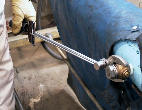 They are also taught with a torque wrench how to apply only
the minimal necessary force to tap...
They are also taught with a torque wrench how to apply only
the minimal necessary force to tap...
fullscreen
 ...and severely penalized if they cause the pipe to bulge out at the tap. As
inspectors, years later, they will make you rip out a whole pipe length if
they think a tap will turn into a crack 30 years later. Why should we
take over a problem a sloppy contractor dumped on us and have to spend
20,000 Euros on it? Why should anybody?
...and severely penalized if they cause the pipe to bulge out at the tap. As
inspectors, years later, they will make you rip out a whole pipe length if
they think a tap will turn into a crack 30 years later. Why should we
take over a problem a sloppy contractor dumped on us and have to spend
20,000 Euros on it? Why should anybody?
fullscreen
 And that's our whole secret. The only problem with plastic pipes is if you
install them incorrectly. And we just employ strict policing on the
construction site.
Thanks for your attention.
And that's our whole secret. The only problem with plastic pipes is if you
install them incorrectly. And we just employ strict policing on the
construction site.
Thanks for your attention.
fullscreen